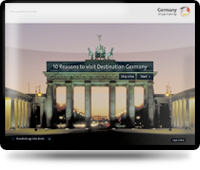Pilgrimage routes in Germany
- "On the trail of strong women"
- In the footsteps of His Holiness, Pope Benedict XVI
- On a pilgrimage your thoughts turn inward as your feet go forward
- On the trail of Saint Boniface
- Next stop - the stars
- Journey of discovery from Hamburg to Viborg
- A pilgrimage between Nuremberg and Constance
- Two paths - one destination
- Pilgrims get a great feeling of satisfaction when they reach their destination
- "Monastery hopping"
- Travelling like the early monks
- A pilgrimage following the shell
- Via Claudia Augusta
- Via Nova
- Via Sacra
Pilgrimage routes in Germany
Pilgrimages have a long tradition and a strong future. But there is more than just one St. James' Pilgrimage Way - it is made up of many different routes. Every year, the veneration surrounding St. James' grave in Santiago de Compostela attracts millions of pilgrims from all over the world along a broad network of interwoven pathways throughout the whole of Europe, as it has done for more than 1,000 years. The archetypal pilgrimage sign, the yellow St. James' shell on a blue background is still used as a symbol on most pilgrimage trails. But it is not just the famous routes through France and Spain that attract travellers. Year after year, more and more pilgrims are setting out to explore the regional pilgrimage trails in Germany, following in the footsteps of ancient pilgrims to historical towns and cities such as Trier, Cologne and Aachen with their famous art and cultural treasures. In the 14th century, Aachen was an important pilgrimage site and a gathering point for pilgrims on the German sections of the St. James' Way. But you will also notice simple hostels, secluded abbeys and modest churches along the way, giving you an insight into the world of medieval pilgrims with their legends, customs, joys and hardships. And being on foot makes the whole experience that much more intense. With regard to luggage, it is advisable to take as much as you need and as little as you can. After all, setting out on a pilgrimage - for personal reasons - has always meant the start of a great adventure.
- "On the trail of strong women"
- In the footsteps of His Holiness, Pope Benedict XVI
- On a pilgrimage your thoughts turn inward as your feet go forward
- On the trail of Saint Boniface
- Next stop - the stars
- Journey of discovery from Hamburg to Viborg
- A pilgrimage between Nuremberg and Constance
- Two paths - one destination
- Pilgrims get a great feeling of satisfaction when they reach their destination
- "Monastery hopping"
- Travelling like the early monks
- A pilgrimage following the shell
- Via Claudia Augusta
- Via Nova
- Via Sacra
Travel Planner
Select an option...
 Skip to content
Skip to navigation
Skip to subnavigation
Skip to search
Skip to content
Skip to navigation
Skip to subnavigation
Skip to search





